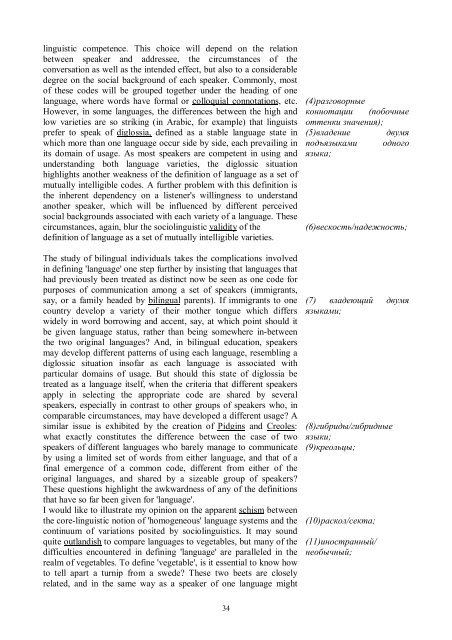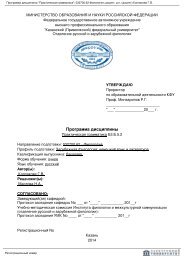Following Best Practice in the High Art of - (Приволжский ...
Following Best Practice in the High Art of - (Приволжский ...
Following Best Practice in the High Art of - (Приволжский ...
Create successful ePaper yourself
Turn your PDF publications into a flip-book with our unique Google optimized e-Paper software.
l<strong>in</strong>guistic competence. This choice will depend on <strong>the</strong> relation<br />
between speaker and addressee, <strong>the</strong> circumstances <strong>of</strong> <strong>the</strong><br />
conversation as well as <strong>the</strong> <strong>in</strong>tended effect, but also to a considerable<br />
degree on <strong>the</strong> social background <strong>of</strong> each speaker. Commonly, most<br />
<strong>of</strong> <strong>the</strong>se codes will be grouped toge<strong>the</strong>r under <strong>the</strong> head<strong>in</strong>g <strong>of</strong> one<br />
language, where words have formal or colloquial connotations, etc.<br />
However, <strong>in</strong> some languages, <strong>the</strong> differences between <strong>the</strong> high and<br />
low varieties are so strik<strong>in</strong>g (<strong>in</strong> Arabic, for example) that l<strong>in</strong>guists<br />
prefer to speak <strong>of</strong> diglossia, def<strong>in</strong>ed as a stable language state <strong>in</strong><br />
which more than one language occur side by side, each prevail<strong>in</strong>g <strong>in</strong><br />
its doma<strong>in</strong> <strong>of</strong> usage. As most speakers are competent <strong>in</strong> us<strong>in</strong>g and<br />
understand<strong>in</strong>g both language varieties, <strong>the</strong> diglossic situation<br />
highlights ano<strong>the</strong>r weakness <strong>of</strong> <strong>the</strong> def<strong>in</strong>ition <strong>of</strong> language as a set <strong>of</strong><br />
mutually <strong>in</strong>telligible codes. A fur<strong>the</strong>r problem with this def<strong>in</strong>ition is<br />
<strong>the</strong> <strong>in</strong>herent dependency on a listener's will<strong>in</strong>gness to understand<br />
ano<strong>the</strong>r speaker, which will be <strong>in</strong>fluenced by different perceived<br />
social backgrounds associated with each variety <strong>of</strong> a language. These<br />
circumstances, aga<strong>in</strong>, blur <strong>the</strong> sociol<strong>in</strong>guistic validity <strong>of</strong> <strong>the</strong><br />
def<strong>in</strong>ition <strong>of</strong> language as a set <strong>of</strong> mutually <strong>in</strong>telligible varieties.<br />
The study <strong>of</strong> bil<strong>in</strong>gual <strong>in</strong>dividuals takes <strong>the</strong> complications <strong>in</strong>volved<br />
<strong>in</strong> def<strong>in</strong><strong>in</strong>g 'language' one step fur<strong>the</strong>r by <strong>in</strong>sist<strong>in</strong>g that languages that<br />
had previously been treated as dist<strong>in</strong>ct now be seen as one code for<br />
purposes <strong>of</strong> communication among a set <strong>of</strong> speakers (immigrants,<br />
say, or a family headed by bil<strong>in</strong>gual parents). If immigrants to one<br />
country develop a variety <strong>of</strong> <strong>the</strong>ir mo<strong>the</strong>r tongue which differs<br />
widely <strong>in</strong> word borrow<strong>in</strong>g and accent, say, at which po<strong>in</strong>t should it<br />
be given language status, ra<strong>the</strong>r than be<strong>in</strong>g somewhere <strong>in</strong>-between<br />
<strong>the</strong> two orig<strong>in</strong>al languages? And, <strong>in</strong> bil<strong>in</strong>gual education, speakers<br />
may develop different patterns <strong>of</strong> us<strong>in</strong>g each language, resembl<strong>in</strong>g a<br />
diglossic situation <strong>in</strong>s<strong>of</strong>ar as each language is associated with<br />
particular doma<strong>in</strong>s <strong>of</strong> usage. But should this state <strong>of</strong> diglossia be<br />
treated as a language itself, when <strong>the</strong> criteria that different speakers<br />
apply <strong>in</strong> select<strong>in</strong>g <strong>the</strong> appropriate code are shared by several<br />
speakers, especially <strong>in</strong> contrast to o<strong>the</strong>r groups <strong>of</strong> speakers who, <strong>in</strong><br />
comparable circumstances, may have developed a different usage? A<br />
similar issue is exhibited by <strong>the</strong> creation <strong>of</strong> Pidg<strong>in</strong>s and Creoles:<br />
what exactly constitutes <strong>the</strong> difference between <strong>the</strong> case <strong>of</strong> two<br />
speakers <strong>of</strong> different languages who barely manage to communicate<br />
by us<strong>in</strong>g a limited set <strong>of</strong> words from ei<strong>the</strong>r language, and that <strong>of</strong> a<br />
f<strong>in</strong>al emergence <strong>of</strong> a common code, different from ei<strong>the</strong>r <strong>of</strong> <strong>the</strong><br />
orig<strong>in</strong>al languages, and shared by a sizeable group <strong>of</strong> speakers?<br />
These questions highlight <strong>the</strong> awkwardness <strong>of</strong> any <strong>of</strong> <strong>the</strong> def<strong>in</strong>itions<br />
that have so far been given for 'language'.<br />
I would like to illustrate my op<strong>in</strong>ion on <strong>the</strong> apparent schism between<br />
<strong>the</strong> core-l<strong>in</strong>guistic notion <strong>of</strong> 'homogeneous' language systems and <strong>the</strong><br />
cont<strong>in</strong>uum <strong>of</strong> variations posited by sociol<strong>in</strong>guistics. It may sound<br />
quite outlandish to compare languages to vegetables, but many <strong>of</strong> <strong>the</strong><br />
difficulties encountered <strong>in</strong> def<strong>in</strong><strong>in</strong>g 'language' are paralleled <strong>in</strong> <strong>the</strong><br />
realm <strong>of</strong> vegetables. To def<strong>in</strong>e 'vegetable', is it essential to know how<br />
to tell apart a turnip from a swede? These two beets are closely<br />
related, and <strong>in</strong> <strong>the</strong> same way as a speaker <strong>of</strong> one language might<br />
34<br />
(4)разговорные<br />
коннотации (побочные<br />
оттенки значения);<br />
(5)владение двумя<br />
подъязыками одного<br />
языка;<br />
(6)вескость/надежность;<br />
(7) владеющий двумя<br />
языками;<br />
(8)гибриды/гибридные<br />
языки;<br />
(9)креольцы;<br />
(10)раскол/секта;<br />
(11)иностранный/<br />
необычный;



